#༺☆༻ 𝕮𝔞𝔫𝔦𝔰 𝕸𝔞𝔧𝔬𝔯 ༺☆༻
Text
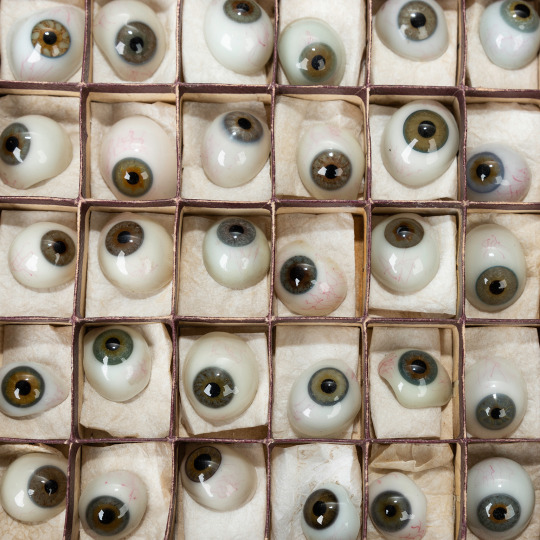

50 Blown Glass Eyes in a Cardboard Box

This set of blown prosthetic glass eyes, presented each in an individal compartment within a cardboard box, dates back to the 1920s.
#༺☆༻ 𝕮𝔞𝔫𝔦𝔰 𝕸𝔞𝔧𝔬𝔯 ༺☆༻#༺✧༻ 𝕸𝔢𝔪𝔬𝔯𝔦𝔞 ༺✧༻#history#vintage#eye#eye imagery#scopophobia#scopohobia tw#prosthetics#glass eye
159 notes
·
View notes
Text
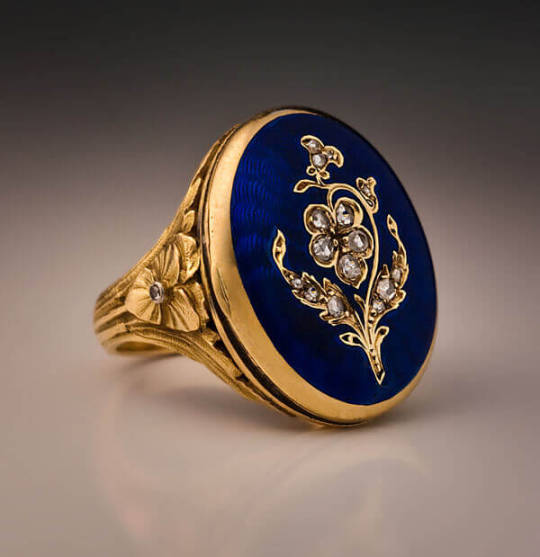
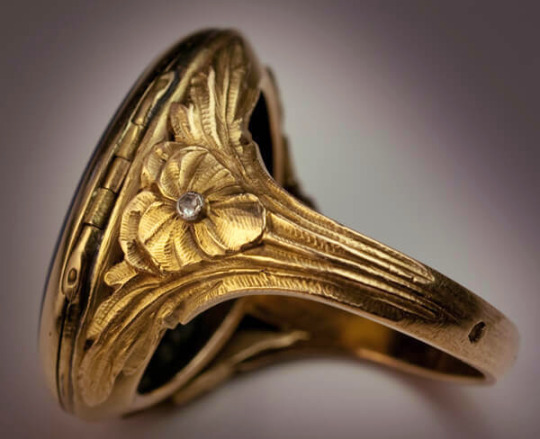
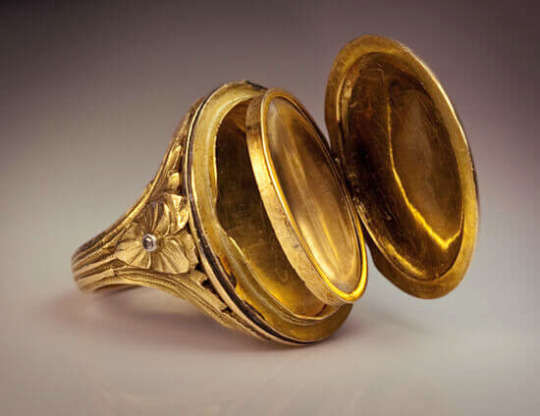
Antique French Enamel Poison Locket Ring

This 19th century French poison locket ring has the secret compartment decorated with a diamond flower on a royal blue guilloche enamel ground. The shoulders are chased with flowers as well while the inside of the ring is suitable for a miniature portrait.
#༺☆༻ 𝕮𝔞𝔫𝔦𝔰 𝕸𝔞𝔧𝔬𝔯 ༺☆༻#༺✧༻ 𝕸𝔢𝔪𝔬𝔯𝔦𝔞 ༺✧༻#history#antique#jewelry#victorian jewelry#poison ring#gold#enamel
55 notes
·
View notes
Text
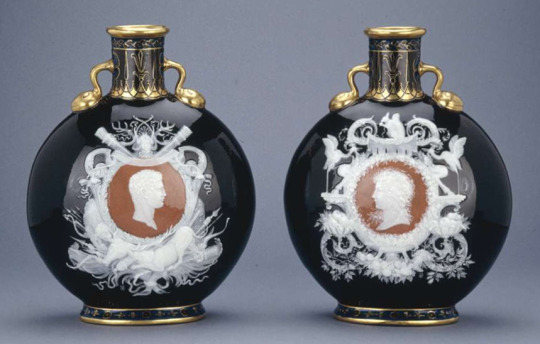
Pair of 'Moon Flasks' decorated by Thomas Mellor for Minton & Co.

These two 19th century flasks are made out of Parian porcelain, glazed dark brown, and present pâte-sur-pâte relief decorations in white of two profile heads in the classical style. One demonstrates the Roman Emperor Augustus (27 BCE – AD 14) and the other has the head of Medusa the Gorgon in a beautiful intaglio.
The flasks are inspired by the Pilgrim bottles of the Chinese Qing dynasty (1644 – 1911), which marks the trend of using various cultural and historical aesthetic aspects in the eclectic mix typical of Victorian England.
The technique used to create the portraits on the flasks was introduced to Thomas Mellor by the French designer Marc Louis Solon (1835 – 1913).
#༺☆༻ 𝕮𝔞𝔫𝔦𝔰 𝕸𝔞𝔧𝔬𝔯 ༺☆༻#༺✧༻ 𝕸𝔢𝔪𝔬𝔯𝔦𝔞 ༺✧༻#art#art history#victorian era#victorian art#parian porcelain#19th century#british museum
40 notes
·
View notes
Text

Leeches were largely popular in the medical field during the Victorian era both in Europe (primarily England and France) and America. The 19th century saw progression of the academic study of leeches as used in medicine that was conducted prior and laid basis for the modern application of anticoagulant in medical practice.
At the time, many famous Englishmen found leeches fascinating: zoologist Arthur Everett Shipley, for instance, wrote papers marveling at the beauty and functionality of a leech. This fascination often grew personal. Lord Thomas Erskine, a lawyer, underwent a successful bloodletting, afterwards taking with him two leeches; later naming them Home and Clina.
According to the memoirs of Sir Sam Romilly, Erskine's friend, he took great care of making sure the leeches "knew him".

In France, the obsession with leeches took drastic turns as well. François-Joseph-Victor Broussais, a notable surgeon of Napoleon's army, was known to possess a certain infatuation with leeches.
Leeches were in growingly high demand in the 19th century Europe. France imported leeches in terrific quantities equating up to dozens of millions a year.

Overall, bloodletting for medicinal purposes is not strictly unique to the 19th century Europe. Like many other medical methods, it has its roots in Ancient Egypt and Greece where bloodletting via cutting veins was often practiced by the followers of the method described in the Hippocratic collection of the 5th century BC. The medicinal use of leeches dates back to 1500 BC and is not a recent invention. However, it is only in 1884 that Haycraft learned why leeches are so efficient in bloodletting: their saliva contains an anticoagulant hirudin (hence hirudotherapy). These observations are listed in Haycraft's work, On the Action of a Secretion Obtained from the Medicinal Leech on the Coagulation of the Blood. For this property, leeches are still in high medicinal demand.
During the Victorian era, leeches were used for all kinds of medical treatment: from headaches to hemorrhoids, from fatigue to nymphomania. Sir William Henry, for example, writes that bloodletting is far beyond any other medical treatment in helping many diseases.

Albeit, the effectiveness of such treatment is a matter of much questioning as often leeching only weakened the fragile state of those being treated. Some patients were, unsurprisingly, allergic to the treatment and either suffered reactions to leeches, larger loss of blood than intended, or even died during treatment.
Leeches and bloodletting were studied with much attention: physicians wrote books on the physiology and medical benefits of leech usage, and a very detailed description of leeches was added in the 1880 edition of Johnson's Universal Cyclopaedia.
The curiosity for leeches found its way into much earlier publications as well. For example, J. R. Johnson released multiple medical studies on leeches in the very beginning of the 19th century. His A Treatise on the Medicinal Leech (1816) and Further Observations in the Medicinal Leech (1825) dwelled on the precise details of leech usage and preservation.

From Johnson's studies mentioned above, we learn that he worked with cocoons of different sizes which he received from other leech enthusiasts. He recorded that leeches are to be kept in an enclosure with a stream of fresh water coming in and turf placed conveniently so that the leeches could "retire in a shady spot". He also studied leeches' detailed anatomical structure.
Such academic interest centered around leeches in England roots within earlier academic research done by the scientists of the 18th century - for example, an apothecary by the name George Horn who published his An Entirely New Treatise on Leeches: Wherein the Nature, Properties and Use in 1798. Interestingly, even this early into the studying of leeches, he mentions the dangers of infections if leeches were to be attracted by walking bare-legged into a river (as was done in India, according to him). Instead, he promotes the English method of agitating the leech-infested waters until the animals come up to the surface to then be caught by the nets. Overall, prior to Horn's manual not many spoke in favor of leeching: William Buchan in his study from 1769 speaks on leeches as unreliable and inefficient as it's unclear how much blood is taken per use.

Horn describes four species of leech (two of which are found in England) and dwells on their peculiar anatomy:
no eyes but a teeth-filled mouth
lips to catch blood from escaping
lack of a proper stomach
presence of the so-called "bags" across their body that "get saturated when leeches receive nourishment"
Based on the gathered information, one can claim leeches were awakening more and more scientific curiosity among the English apothecaries and physicians even at the end of the 18th century.
The medical treatment of patients with the use of leeches is described by Horn as well, though he tends to recommend additional treatment - usually mixtures of milk and syrup with herbs - to be given to the patient alongside bloodletting. This as well as other studies of the late 18th century certainly became the basis of medicinal usage of leeches in the upcoming 19th century and far into the 1910s.

It is impossible to speak of leech therapy of the early 19th century in England and beyond without mentioning the influence of François-Joseph-Victor Broussais, a surgeon of immense medical fascination with leeches who employed them vastly in his treatment of Napoleon's soldiers. Broussais used around fifty leeches a time per patient and was thus called "the vampire of medicine" for his fascination with bloodletting. He claimed, among other things, that all "fevers" had the precisely same origin: inflammation. Letting out "bad blood" was thus a plausible solution to the issue.
Women wore embroidery in colors inspired by leeches' dim, soft shades. A whole sort of fashion - à la Broussais - was born out of this unusual fascination. The notable traits of this fashion, according to Michel Valentin who wrote a large biography of Broussais, were purple garnitures - embroidery, trimming - and top coats that resembled leeches' colors.
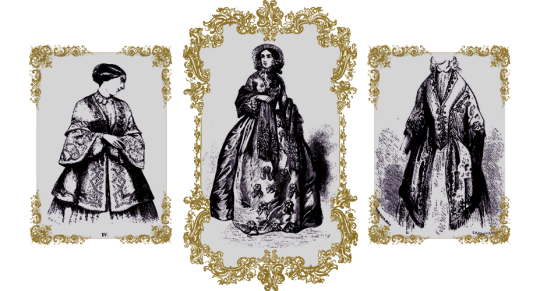
This conclusion was, of course, the result of the "humoral theory", which was widely supported in Europe. Rooting from Greece, it centered around the idea that the human body held inside four types of liquids: two kinds of bile, phlegm, and blood. Each humor was associated with two qualities, either hot or cold, and either wet or dry. Having one of the liquids "in excess" was associated with certain conditions (for blood, it was any that caused redness, for example), hence bloodletting was a naturally sought out practice.
The leeches were placed “inside the nostrils, on the inside of the lower lip, on the chest, and on the side, sometimes by four at a time.”
Leeches could access otherwise inaccessible parts of one's body (such as perineum) and were often used for treatment conditions that were believed to be connected to genitalia - for example, "nymphomaniac" states.
To apply a leech, one would hold a small leech-containing vessel filled with water to the desired spot, wait until it bites, and then gently remove the container; tubes could be used as well.
A whole industry related to leeches was established in the 19th century: propagating leeches rose to the state level of importance and leech keeping became a popular activity. Leeches were, in fact, nearly hunted to extinction in some European countries in the 19th century, including England. Containing leeches started to become complicated: leeches only needed meals once every six months (and thus were not suitable for frequent use) and required specific conditions of containment. Thus, the mechanical leech quickly became a popular invention. The first prototype of 1817, called bdellomètre, is credited to French doctor Jean-Baptiste Sarlandière.

Transactions of the Pharmaceutical Meetings (1855) notes some statistical numbers regarding the "leech hunt" of the 19th century: in imports alone England received 8 million leeches annually, besides the large numbers collected within the country. The practice of using mechanical leeches (two types for different purposes) is mentioned as "ingenious" and discussed as a great opportunity to keep the natural leech healthy. The book tracks down purchases of various vessels for fresh water used as leech enclosures.
Actual preservation and propagation of leeches are described in various books of the time, though the peak of such publications in England comes around in the 1850s.
In 1855, Specification of Nathaniel Johnston: Breeding, Rearing and Carrying Leeches is published. Johnston, whilst in Paris, invented an apparatus for keeping and breeding medicinal leeches: a complicated water vessel to keep leeches at the perfect temperature and humidity for the breeder - the inventor titled these containers hirudinieres. A similar invention was marked by another author in Specification of George Lifford Smartt: Vessels for Preserving Leeches and Fish Alive.

There was a lot of thought and effort put into keeping leeches healthy and vital - either for medicinal purposes or out of personal fascination.
#༺☆༻ 𝕮𝔞𝔫𝔦𝔰 𝕸𝔞𝔧𝔬𝔯 ༺☆༻#historyblr#english history#french history#victorian history#medical history#victorian era#victorian#18th century#19th century
57 notes
·
View notes
Text

Catherine of Braganza in a Chariot

This ceiling painting was created in 1675 - 1684 by Antonio Verrio (1639-1707), an Italian artist. It was commissioned by Charles II and, currently, is only one of three at Windsor to survive. Most of the artist's work at the site was destroyed when George IV reconstructed the castle in the beginning of the 19th century.
The piece centers the figure of Catherine of Braganza, wife of King Charles II. She is portrayed among the clouds, drawn in a chariot pulled by swans. The Queen is accompanied by a putto carrying the Coat of Arms and a zephyr with a crown.
Verrio derived his inspiration largely from Le Brun who created mythological schemes for Louis XIV at the Palace of Versailles. For his undeniable skill in creating complex, colorful, and monumental pieces of art, Antonio Verrio was continually employed by the reigning King from 1678 until 1688. John Evelyn (1620-1706), upon seeing the construction, reported: "that excellent painter, Verrio, whose works in fresco at the King's Palace at Windsor will celebrate his name as long as those walls last".
#༺☆༻ 𝕮𝔞𝔫𝔦𝔰 𝕸𝔞𝔧𝔬𝔯 ༺☆༻#༺⚚༻ 𝕲𝔞𝔩𝔩𝔢𝔯𝔦𝔞 ༺⚚༻#art#art history#windsor castle#italian art#antonio verrio#17th century
35 notes
·
View notes
Text

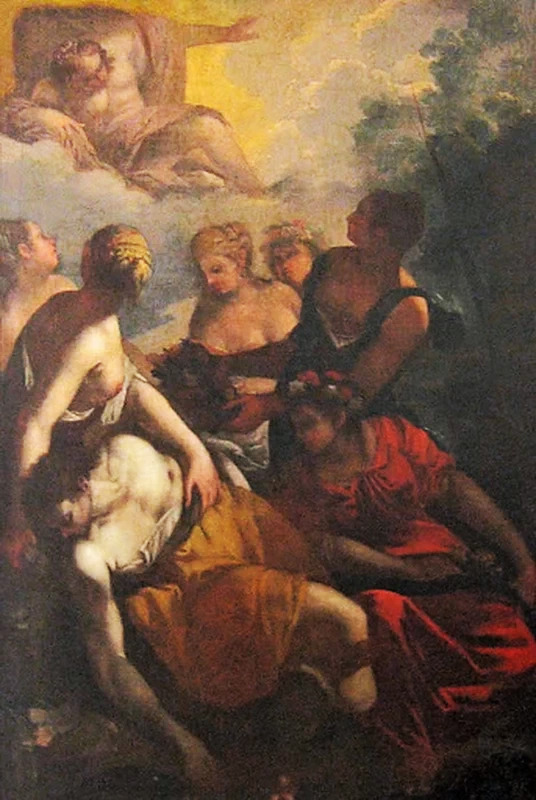
Drunk Maenad with a harpsichord and Dionysus appearing in the clouds to the Maenads

These canvases are attributed to Biagio Falcieri (Brentonico, 1628 - Verona, 1703), an Italian painter who depicted many scenes with Olympic Divinities.
Four of his pieces were donated to Fondazione Museo Miniscalchi-Erizzo by Giulio and Gianna Prosdocimo in memory of their daughter Franca: Aphrodite triumphantly advances in a riot of flowers, Feast on Olympus, Dionysus appears in the clouds to the Maenads, and Drunk Maenad with a harpsichord.
#༺☆༻ 𝕮𝔞𝔫𝔦𝔰 𝕸𝔞𝔧𝔬𝔯 ༺☆༻#༺⚚༻ 𝕲𝔞𝔩𝔩𝔢𝔯𝔦𝔞 ༺⚚༻#art#art history#17th century#Bartolomeo Guidobono#italian art#greek mythology#mythology art#maenad#dionysus#bacchus#tagamemnon
43 notes
·
View notes
Text

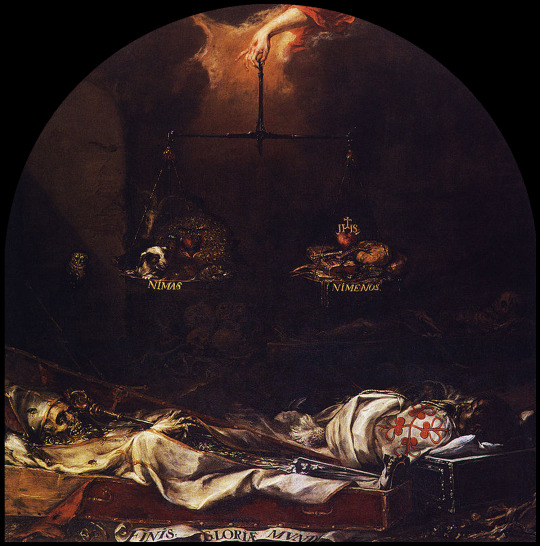
In Ictu Oculi and Finis Gloriae Mundi

These paintings are a pair of chilling, grim works commissioned for the Hospital de la Caridad and created by Juan de Valdés Leal (1622-1690), Baroque artist. The art pieces are masterful allegories of Death intended to remind the viewer of how universal Death is and how fleeting are the earthly delights.
Together, the paintings make up Las Postrimerías - the Afterlife.
In Ictu Oculi ("in a blink of an eye") shows a grim reaper exstinguishing a candle - above it the titular text that implies the quickness with which a life goes out like a flame.
Finis Gloriae Mundi ("end of worldly glory") depicts two rotting corpses, a bishop and a knight, laying in a crypt and surrounded by allegories of money and status.
#༺☆༻ 𝕮𝔞𝔫𝔦𝔰 𝕸𝔞𝔧𝔬𝔯 ༺☆༻#༺⚚༻ 𝕲𝔞𝔩𝔩𝔢𝔯𝔦𝔞 ༺⚚༻#art#art history#baroque#baroque art#juan de valdes leal#in ictu oculi#finis gloriae mundi#macabre#grim reaper#skeleton#death aesthetic#dark academia
40 notes
·
View notes
Text



Landscape with Orpheus and Eurydice by Nicolas Poussin (1648)

Orpheus in the Underworld by Roelant Savery (1610/1615)

Orpheus playing to Pluto and Proserpine by Jan Brueghel the Elder (1594)

#༺☆༻ 𝕮𝔞𝔫𝔦𝔰 𝕸𝔞𝔧𝔬𝔯 ༺☆༻#art#french art#dutch art#flemish art#16th century#17th century#greek mythology#orpheus#eurydice#orpheus and eurydice#hades#persephone#pluto#proserpina
52 notes
·
View notes
Text

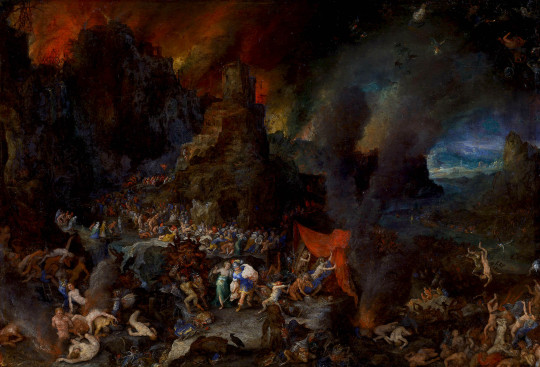
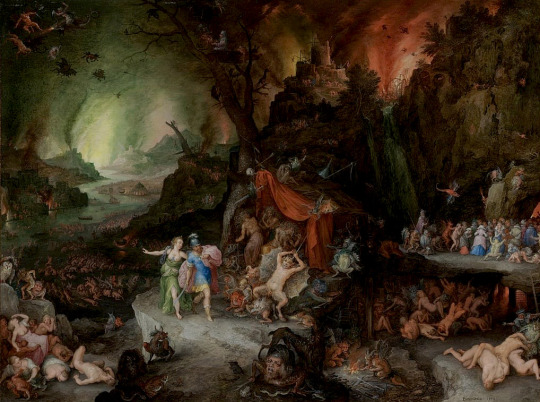
Aeneas and the Sibyl in the Underworld by Jan Brueghel the Younger (1630s)

Aeneas and the Sibyl in the Underworld by Jan Brueghel the Elder (1600s)

Aeneas and the Sibyl in the Underworld by Jan Brueghel the Elder (1600s)

#༺☆༻ 𝕮𝔞𝔫𝔦𝔰 𝕸𝔞𝔧𝔬𝔯 ༺☆༻#༺⚚༻ 𝕲𝔞𝔩𝔩𝔢𝔯𝔦𝔞 ༺⚚༻#art#tagamemnon#flemish art#17th century#Jan Brueghel the Elder#Jan Brueghel the Younger#mythology#roman mythology#aeneas#sybil
38 notes
·
View notes
Text

Still Life with Rabbit and Fowls

A piece of natura morta created by famous Italian painter Gabriele Salci (Rome, first half of the 18th c.) in 1719.
#༺☆༻ 𝕮𝔞𝔫𝔦𝔰 𝕸𝔞𝔧𝔬𝔯 ༺☆༻#༺⚚༻ 𝕲𝔞𝔩𝔩𝔢𝔯𝔦𝔞 ༺⚚༻#baroque art#italian art#Gabriele Salci#18th century#eighteenth century#tw animal death
32 notes
·
View notes
Text


Antique Victorian Cherub Portrait Pendant Watch, with Crowned Winged Watch Pin Brooch

This 18k gold pendant with a matching 14k gold pin dates back to the year 1895. The watch itself is decorated with a polychrome enamel portrait of three rose-cheeked cherubs in fluffy clouds.
The portrait is framed with cobalt blue guilloché enamel studded with rose cut diamonds, which continues on the reverse.
This antique watch is accompanied by its original pin, a crowned pair of wings set with old cut diamonds and pearls.
#༺☆༻ 𝕮𝔞𝔫𝔦𝔰 𝕸𝔞𝔧𝔬𝔯 ༺☆༻#༺✧༻ 𝕸𝔢𝔪𝔬𝔯𝔦𝔞 ༺✧༻#history#art#antiquities#vintage#victorian#victorian jewelry#jewelry#19th century#angels#cherubs
23 notes
·
View notes
Text

Iris in the Realm of Morpheus

This painting was created by the Italian early Baroque painter and etcher Giulio Carpioni (1613 – 29 January 1678) in 1660–1665.
#༺☆༻ 𝕮𝔞𝔫𝔦𝔰 𝕸𝔞𝔧𝔬𝔯 ༺☆༻#༺⚚༻ 𝕲𝔞𝔩𝔩𝔢𝔯𝔦𝔞 ༺⚚༻#art#baroque art#italian art#Giulio Carpioni#greek gods#Iris#Morpheus
20 notes
·
View notes
Text

𝐓he 𝐒𝐏𝐈𝐑𝐈𝐓 𝐓𝐑𝐔𝐌𝐏𝐄𝐓 is a rather peculiar occult invention of the late 19th century.
Prior to the invention of this tool, mediums had to use nonverbal means of spirit communication, be it spirit boards or other similar objects. However, the spirit trumpet suggested, for the first time, that a spirit can physically reach the listener through audial means as well.
As Victorian Women and the Theatre of Trance: Mediums, Spiritualists and Mesmerists in Performance (2009) by Amy Lehman states, it was a part of the greater "manifestation" category of mystical experiences. During manifestation, the spirits made objects levitate or appear, such as flower petals or letters, as well as played instruments - guitars, tambourines, or trumpets.

A spirit trumpet is shaped like a usual trumpet from two and a half to three feet in length, traditionally made of brass, tin, or aluminum; fibre and papier mache are acceptable materials as well. Four to five inches in diameter at the larger end, they narrow down to just about three-quarters of an inch at the other end. Every medium seemingly had their own design and variations of shape for their spirit trumpet.
The first spirit trumpets were homemade, usually shaped out of cardboard or metal. While it is unclear who came up with the idea of a spirit trumpet, sometimes Jonathan Koons (1811-1893) and his son Nahum Koons (1837-1921), influential spiritualists of the 19th century, are credited with it.
The first commercial manufacturer of this tool was Everett Atwood Eckel (1831-1914) who opened his shop in Indiana.
In practical use, it was often recommended that a trumpet be wet on the inside prior to the seance as the moisture supposedly helped spirits speak easier. Some sceptics suggested that the practice had a more down-to-earth reasoning behind it as it helped hide the moisture from the medium speaking into the trumpet: such an opinion was voiced in The Life and Mysteries of the Celebrated Dr. Q (1921) by Alexander the Crystal Seer, an all-revealing manual on spiritual performances.

In the aforementioned book, Mr. Alexander, who himself was a stage magician, is rather critical of this method of spirit communication. He speaks, for one, on how suspicious the seances involving the spirit trumpet seem to be: set in dark or semi-dark rooms with light conveniently placed so that the podium for the trumpet is cast in darkness.
From the same author we learn of the general setting of the seance and its approximate contents. Such as, a prayer being said, the medium inviting over the spirit and putting the trumpet on their knees, after which everyone present holds hands with those sitting on their left and right. Once the spirit arrives, the trumpet is expected to lift in the air, slowly turning around, and either emit glowing light, ooze ectoplasm, or simply echo voices. From his skeptical viewpoint, Mr. Alexander suggests an element of deception being involved: either the medium using a hose to talk, feigning different voices, or using a special system of strings in the complete darkness to make the trumpet move.

However, Mr. Alexander wasn't the pioneer of criticism of the method. One of the first research pieces that regarded the problem of trumpet seances was Experiments in psychical science, levitation, contact, and the direct voice (1919) by a psychic researcher William Jackson Crowford. He was the one to point out that sometimes mediums used glow-in-the-dark rings on the ends of the trumpets and set them in complete darkness with the visitors singing hymns or praying before the start of the seance. During one of the seances he witnessed, Mr. Crowford claims, the trumpets flew in the air and requested a lamp to be turned away from the medium while those present "sing something". Some mediums used bells or boards to announce the spirit's presence.
Out of other critical articles about the method, Mysteries of the Seance and Tricks and Traps of Bogus Mediums: A Plea for Honest Mediums and Clean Work (1903) by an unknown herbalist can be noted. In this work, the author, following Mr. Alexander, states that the spirit trumpet seance is overall a fraud. He marks that by usage of little to no light and layered clothing, a medium could either conceal a hose or hide a second trumpet. Overall, he recommends that the stories of those who went through the trumpet seance should be taken with a grain of salt.

There were, indeed, such stories. In The Physical Theory of the Soul (1915) by Harry La Verne Twining, one can read about such an experience. Within this book, the eyewitness of a seance presents their point of view. The trumpet is said to have lifted into the air and bumped them on their head, announcing a name that was familiar to them, as well as their name.
After a short interaction, the trumpet fell down and lifted yet again, giving out another name, this time a relative of both the first presumed spirit and the person listening. What the eyewitness here notes to be a unique occassion is the voice mentioning something that only the eyewitness knew: an event from around twenty-seven years ago. To futher dissipate the suspicion, the person notes that both of the mediums must have been but toddlers at the time of the event, and it's "impossible" they knew about it.
Other observations by the witnesses and visitors of such seances are plenty as well. One of them is told in the book A Record of Psychic Experience (1922) by George F. Goerner. The trumpet seance described in the text suggests multiple spirits, all somehow connected to the listener, speaking to him through either his or the medium's trumpet. He hears, for example, many of his deceased relatives and his friend. Out of the curious details regarding this experience is that the medium suggests one is to keep friendly, positive attitude during the seance as this "clears the way" for the dead. Another detail described in the account is that the medium is accompanied by a person under the role of a spirit control assistant.

Overall, there's a lot of interesting and various information about the spirit trumpet. Some seemed highly cautious about it, sometimes for a good reason, and for some it was a rather relieving way of soothing the loneliness after their beloved ones had passed.
Regardless, it is a tool worth discussing.
#༺☆༻ 𝕮𝔞𝔫𝔦𝔰 𝕸𝔞𝔧𝔬𝔯 ༺☆༻#occult#occulltism#witchcraft#spirit communication#spirits#victorian history#victorian#spirit trumpet#19th century
15 notes
·
View notes
Text

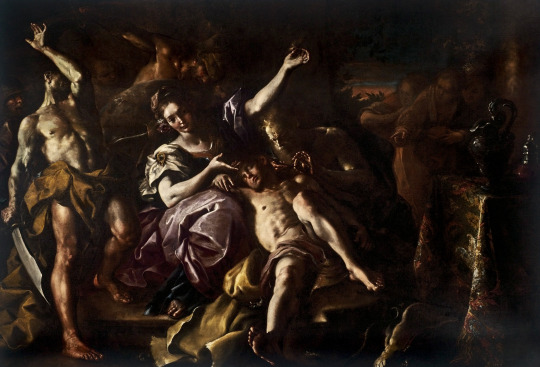
Giaele e Sisara and Sansone e Dalila by Bartolomeo Guidobono

These canvases by Bartolomeo Guidobono (Savona, 1654 - Turin, 1709) are the most recent acquisitions of the National Gallery of Liguria in Genoa. The monumental pieces depict two biblical scenes from the Old Testament. They most likely belonged to the Spinola family. After the Spinola di Pelliceria palace was donated and became the modern National Gallery of Liguria, the works were found to have been directly connected to the family's inventories and were likely commissioned by one of its members.
Guidobono was one of the most fascinating artists of the late 17th century Genoa. Until recently, there were no pieces by this painter at the National Gallery but a generous donation gifted the canvases to the museum. The pieces were published by an art historian Ezia Gavazza, specialist in seventeenth-century Genoese art.
#༺☆༻ 𝕮𝔞𝔫𝔦𝔰 𝕸𝔞𝔧𝔬𝔯 ༺☆༻#༺⚚༻ 𝕲𝔞𝔩𝔩𝔢𝔯𝔦𝔞 ༺⚚༻#art#art history#italian art#genoese art#biblical art#old testament#Bartolomeo Guidobono
12 notes
·
View notes
Text

Ercole combatte contro Thanatos per liberare Alcesti
Hercules fights Thanatos to free Alcestis

This oil painting was created by an outstanding Italian artist Filippo Pelagio Palagi (1775 - 1860) who was especially fascinated by Etruscan, Roman, Egyptian, and Greek Antiquity. Unfortunately, the precise year of creation remains unknown.
The motif that inspired this painting is a narrative within Greek mythology that speaks on Alcestis, a wife of king Admetus, who loved her husband enough to offer herself to Death when his time comes. Hercules, enraged, fights Thanatos to save the woman's soul.
This specific version of the myth is told by Euripides in his Alcestis.
#༺☆༻ 𝕮𝔞𝔫𝔦𝔰 𝕸𝔞𝔧𝔬𝔯 ༺☆༻#༺⚚༻ 𝕲𝔞𝔩𝔩𝔢𝔯𝔦𝔞 ༺⚚༻#tagamemnon#greek mythology#classic art#italian art#Filippo Pelagio Palagi
12 notes
·
View notes
Text
𝟏𝟓:𝟑𝟓
It's more comfortable to blame my naivety on being hurt than to accept that someone had the intentions to hurt me.
15 notes
·
View notes